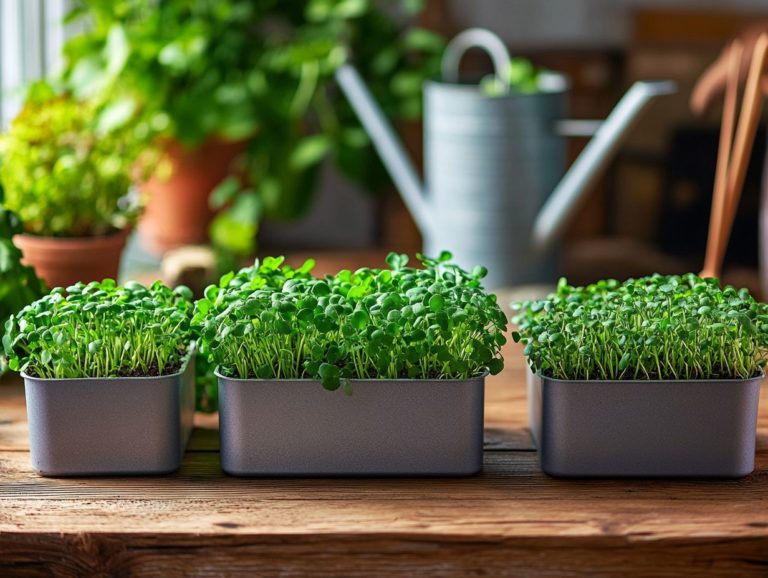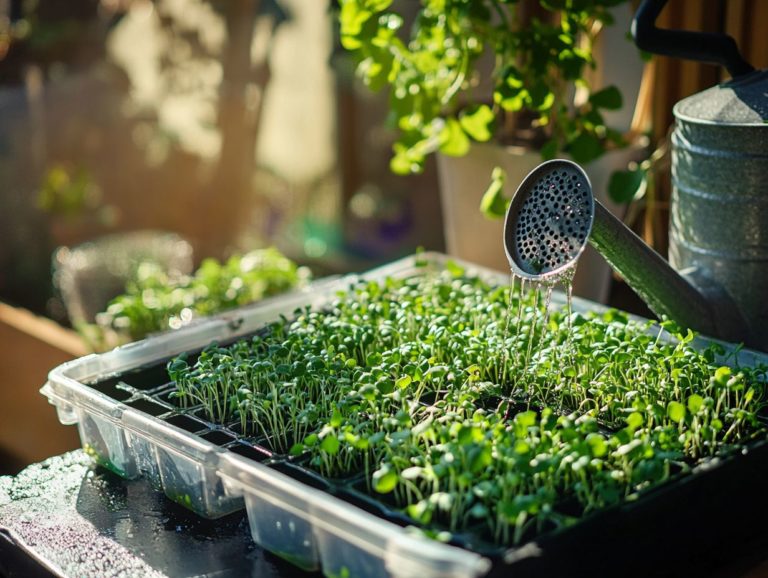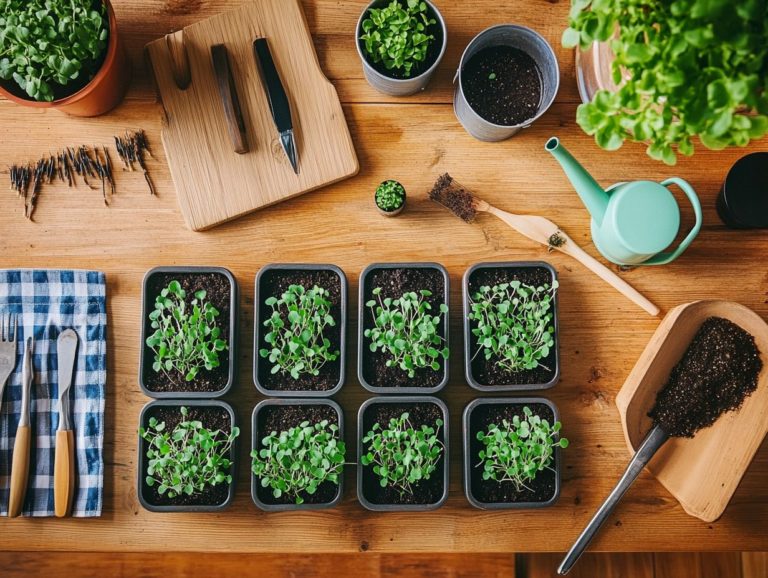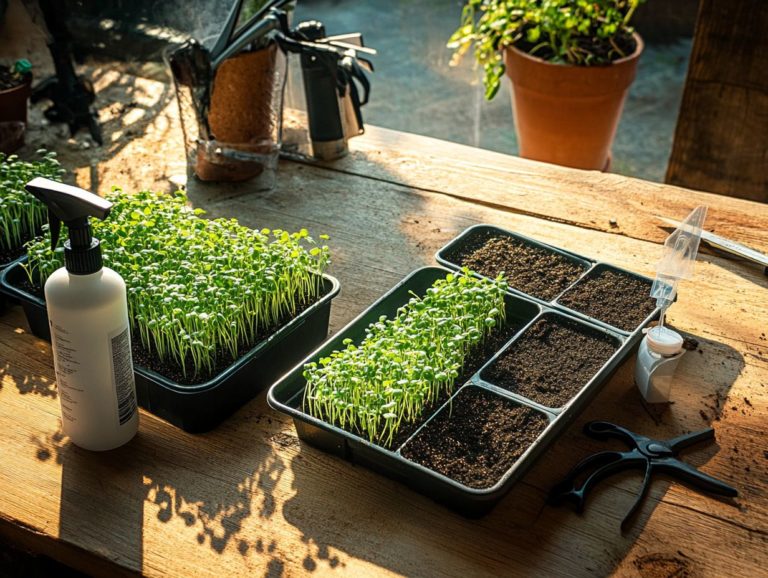Essential Fertilizers for Microgreen Growth
Microgreens are tiny plants packed with nutrients that have captivated the culinary world.
To grow these greens successfully, understanding the importance of fertilizers is vital.
This article explores how fertilizers help with growth, nutrition, and flavor enhancement of microgreens.
Discover different types of fertilizers, both organic and synthetic. You’ll also learn best practices and how to avoid common mistakes, like over-fertilizing, while exploring methods like compost tea.
Whether you re a seasoned gardener or just starting out, this guide will help you grow delicious microgreens with confidence.
Contents
- Key Takeaways:
- The Importance of Fertilizers for Microgreens
- Types of Essential Fertilizers for Microgreens
- How to Properly Fertilize Microgreens
- Common Mistakes to Avoid
- Alternative Methods for Fertilizing Microgreens
- Frequently Asked Questions
- What are essential fertilizers for microgreen growth?
- Why do microgreens need fertilizers?
- What are the main nutrients microgreens need for growth?
- What is the best type of fertilizer for microgreens?
- How often should fertilizers be applied to microgreens?
- Are organic fertilizers suitable for microgreens?
Key Takeaways:

- Microgreens require fertilizers for optimal growth and nutrition.
- Organic fertilizers are preferred for microgreens, but specific types may vary based on the microgreen variety.
- Proper application and avoiding common mistakes, such as over or under-fertilization, are crucial for successful microgreen growth, especially when using a suitable potting mix.
What are Microgreens?
Microgreens are young, edible plants harvested shortly after germination, typically within 7 to 21 days. These tiny treasures are bursting with flavor and nutrients, making them a favorite in both culinary and health circles.
Popular varieties include Purple Vienna Kohlrabi and Genovese Basil, known for their vibrant colors and rich tastes.
Whether you choose to grow them at home or buy them commercially, microgreens offer an organic solution for those seeking fresher ingredients in their meals. Their rapid growth makes them versatile, easily cultivated indoors or outdoors, which is ideal for urban gardening.
These miniature powerhouses are visually appealing and their nutritional profiles can outshine their mature counterparts. Packed with vitamins, minerals, and antioxidants, microgreens enhance a balanced diet.
If you’re considering growing your own, start with high-quality organic seeds to maximize flavor and health benefits. Varieties like Radish and Sunflower add unique tastes and textures that elevate your dishes.
By incorporating a variety of microgreens into your cooking, you can enrich your meals while enjoying the rewarding experience of nurturing your own organic garden.
The Importance of Fertilizers for Microgreens
Fertilizers are essential for cultivating microgreens, greatly affecting how they grow, taste, and their nutritional profile.
Choosing the right fertilizer ensures these delicate plants receive vital nutrients during their short growth cycles.
Consider options like Hero Organic Plant Food, which is specially formulated for microgreens and promotes vigorous growth while enhancing flavor.
By understanding the unique requirements of your microgreens, including the right fertilizer and its application, you can greatly improve both the yield and quality of your greens.
How Fertilizers Supercharge Your Microgreens
Fertilizers enhance the growth and nutrition of your microgreens by supplying essential nutrients often lacking in standard soil or potting mixes.
These nutrients nitrogen, phosphorus, and potassium are crucial for your plants’ development and overall health.
With the right type of fertilizer, expect faster growth rates and more flavorful microgreens.
Apply fertilizers during the early stages of seedling development to lay a strong foundation for vigorous growth.
Recognize the role of micronutrients like iron, manganese, and zinc, which contribute to robust growth and enhanced flavors.
Techniques like foliar feeding applying nutrients directly to the leaves allow for quick nutrient absorption, while slow-release fertilizers ensure a steady supply over time.
By maintaining a balanced nutrition regimen, you can expand flavor profiles and bolster your plants’ resilience against pests and diseases, leading to a thriving microgreen garden.
Types of Essential Fertilizers for Microgreens
Understanding the types of fertilizers essential for microgreens is key to achieving optimal growth and flavor. Fertilizers can be broadly categorized into organic and synthetic types, each bringing its own advantages and disadvantages.
For instance, organic fertilizers like Hero Organic Plant Food offer a slow-release source of nutrients that enrich the soil over time, creating a robust foundation for your microgreens. Synthetic fertilizers, on the other hand, deliver a quick nutrient boost, perfect for fast-growing varieties.
When selecting a fertilizer, consider the specific needs of the microgreens such as Purple Vienna Kohlrabi and Genovese Basil to ensure each variety receives the best support.
Organic vs. Synthetic Fertilizers
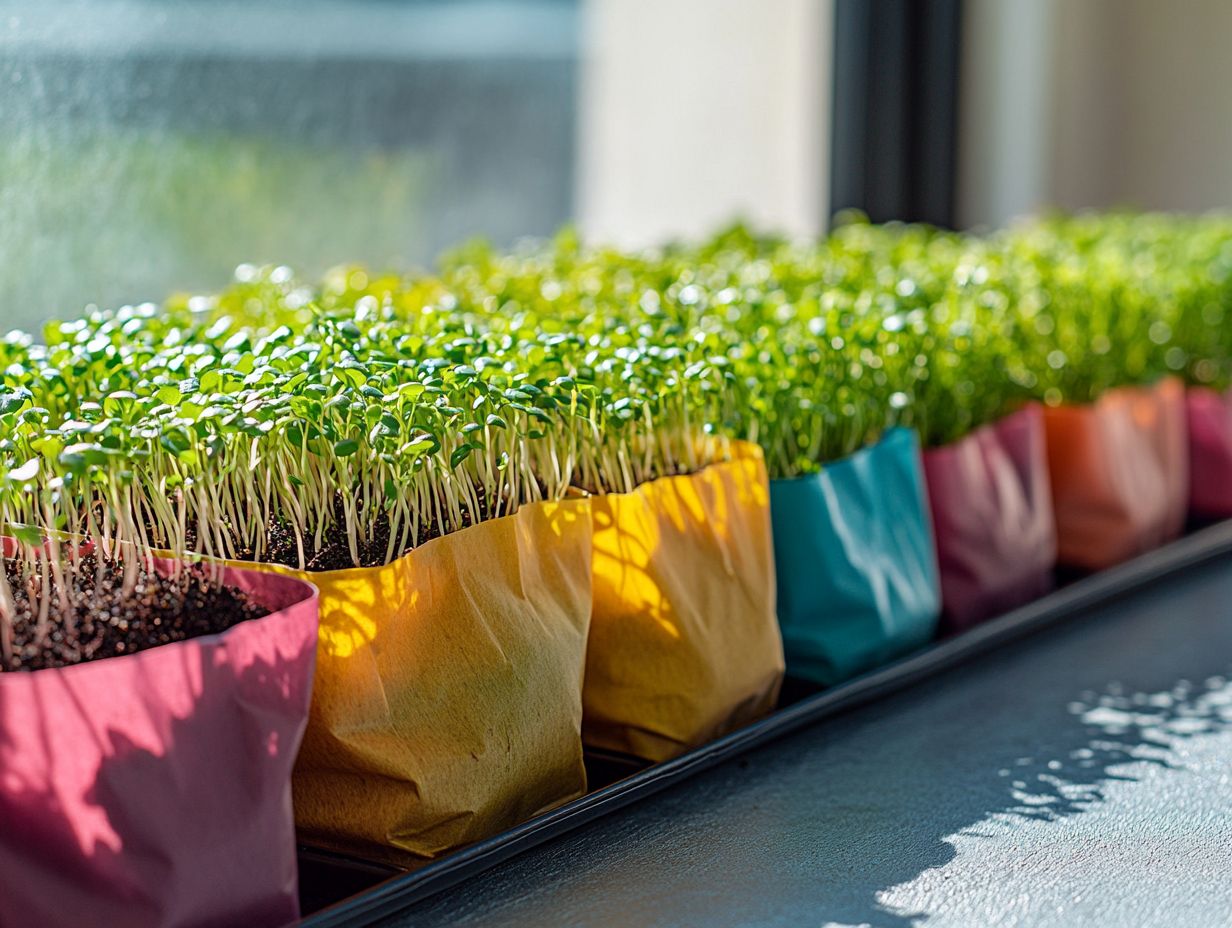
Choosing between organic and synthetic fertilizers is crucial for your microgreens’ success. Each type influences both the plants and the environment in distinct ways.
Organic fertilizers, such as compost and manure, do more than just enrich your soil with essential nutrients; they foster beneficial microbial activity, creating a balanced ecosystem that supports plant health over time. A case study on arugula microgreens showed that those nurtured with organic compost had enhanced flavor profiles and greater nutrient density compared to counterparts that relied on synthetic options.
Synthetic fertilizers like ammonium nitrate or FoxFarm may promise rapid growth but can deplete the soil s vitality over time, potentially compromising both the taste and the nutritional quality of your microgreens.
This distinction in nutrient content, combined with different application methods, emphasizes the importance of choosing fertilizers that align with your growth objectives and commitment to environmental sustainability.
Specific Fertilizers for Different Types of Microgreens
Different microgreens thrive best with specific fertilizers tailored to their unique growth requirements. For example, if you’re cultivating nutrient-sensitive varieties like Purple Vienna Kohlrabi, Hero Organic Plant Food is an exceptional choice. Other microgreens might flourish with a different fertilizer formulation.
Understanding the unique needs of each variety can supercharge their growth and flavor, making it essential to select the right fertilizer for your microgreen garden.
This meticulous attention ensures you effectively utilize resources, providing each plant with the precise balance of nutrients necessary for vigorous growth.
Take Sunflower microgreens, for instance. They are known for their robust flavor and texture, and they generally do best with a balanced fertilizer rich in nitrogen and phosphorus, like a 10-10-10 formulation. To ensure optimal growth, it’s also crucial to understand how to choose the right soil for microgreen growth. Nutrient-dense options like Broccoli microgreens shine when treated with a fertilizer high in calcium, promoting strong root development.
By tailoring these essential nutrients, you can cultivate healthy plants, such as Sunflower microgreens, that lead to improved harvest quality and enhanced flavor profiles.
How to Properly Fertilize Microgreens
Proper fertilization of microgreens is essential for promoting healthy growth and maximizing yield. It requires a keen understanding of the best practices for application and timing specific to each variety.
Begin by selecting the ideal potting mix, often incorporating components like pure coconut coir for optimal drainage and aeration. Once your microgreens are established, apply fertilizers based on the specific needs of the plants, ensuring even distribution while being gentle on the delicate seedlings.
This thoughtful approach fosters robust growth and elevates the flavor of your microgreens.
Best Practices for Application
Applying fertilizers correctly is essential for your microgreens success. Improper application can lead to problems like nutrient burn or insufficient nourishment. To ensure optimal results, dilute liquid fertilizers to the recommended concentration and apply them early in the growth stage when your seedlings are most receptive.
It s crucial to monitor the moisture levels of the potting mix during fertilizer application. This ensures your microgreens receive the hydration they need for effective nutrient absorption, ultimately enhancing their growth and flavor.
Timing matters significantly; applying fertilizers too early or too late can disrupt proper development. Consider applying nutrients directly to the leaves, as this technique can be particularly effective for quicker uptake. When applying fertilizers to the soil, be vigilant to prevent over-fertilization, which could lead to salt buildup. Regularly check your microgreens for signs of nutrient deficiencies or excess to guide your future applications.
Balancing water levels is equally critical; without sufficient moisture, even the finest fertilizers can falter. Finding the right balance is key for optimal growth.
Common Mistakes to Avoid
Avoiding common mistakes in the fertilization process is essential for ensuring successful growth in your microgreens. Many growers find themselves either over-fertilizing or under-fertilizing, leading to poor flavor, stunted growth, or even the untimely demise of their plants.
Recognize the symptoms of these errors like yellowing leaves signaling over-fertilization or sluggish growth indicating under-fertilization so you can make adjustments promptly. By understanding and addressing these pitfalls, you can guarantee the vitality and exceptional flavor of your microgreens.
Effects of Over or Under-Fertilization
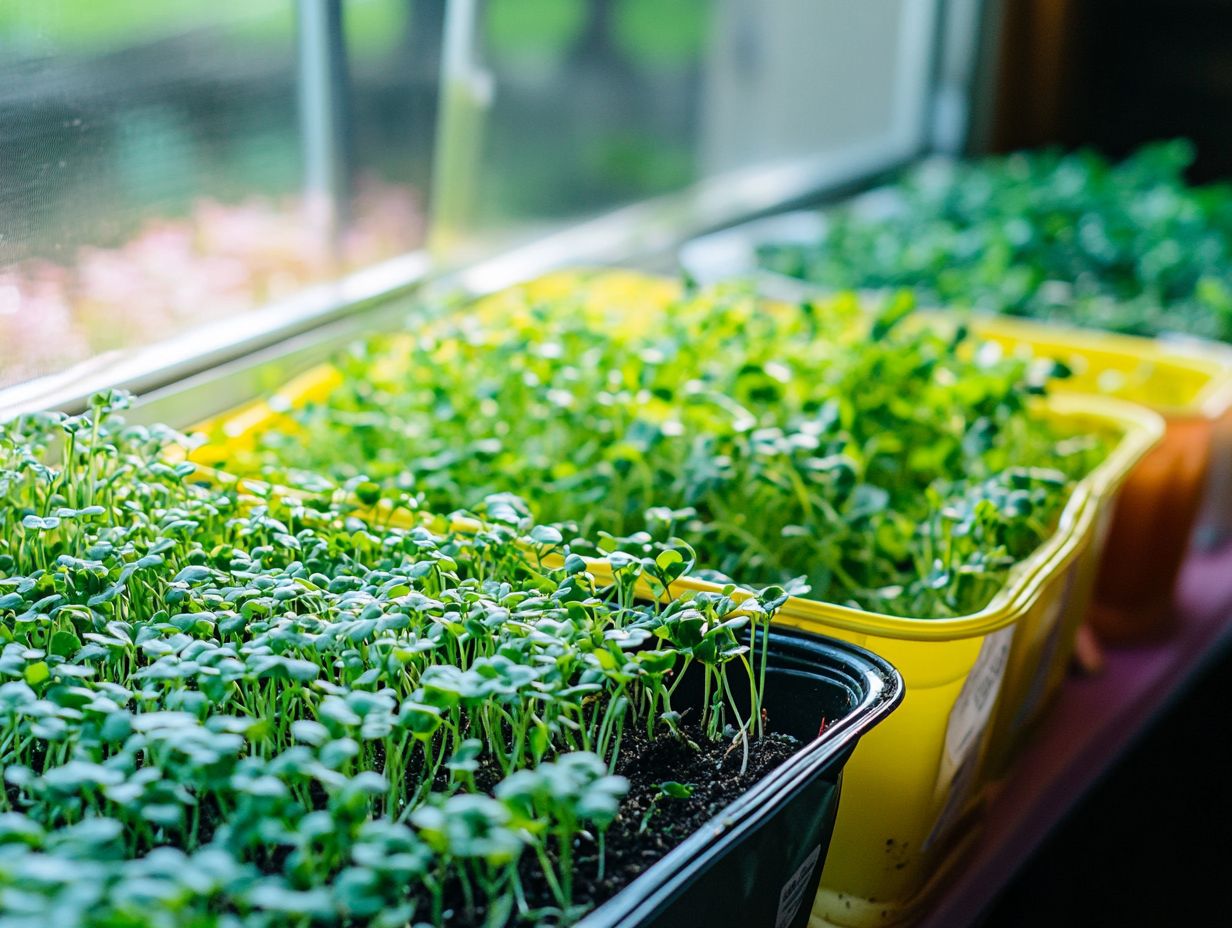
Over-fertilization and under-fertilization can wreak havoc on the growth and quality of your microgreens, leading to a host of issues, from nutrient burn to lackluster flavor profiles. You might notice yellowing leaves or wilting when you over-fertilize, while under-fertilization can leave your plants weak and lacking vibrancy.
By understanding these effects, you can make informed decisions about your fertilization practices, ensuring your microgreens reach their peak in taste and nutrition.
The balance of nutrients is crucial for the overall health of your microgreens. For example, too much nitrogen can promote lush growth but compromise flavor, making your sprouts taste bitter or overly pungent. Conversely, a deficiency in essential minerals like phosphorus can stifle root development, resulting in frail shoots.
Growers who monitor their nutrient levels achieve significantly better outcomes. Consider these tips:
- Test soil pH regularly.
- Adjust your fertilization schedules based on plant maturity.
- Observe how your plants respond after applying fertilizers.
Catch nutrient imbalances early to boost your microgreens growth and flavor!
Alternative Methods for Fertilizing Microgreens
Exploring alternative fertilization methods for microgreens opens the door to innovative solutions that elevate growth and nutrition, all without relying solely on commercial fertilizers.
Consider options like compost tea and various natural amendments, which deliver rich, organic nutrients that integrate seamlessly into your microgreen cultivation. These alternatives not only supply essential nutrients but also encourage beneficial microbial activity in the soil, creating a thriving growing environment.
By incorporating these methods, you can cultivate flavorful and nutritious microgreens while adhering to sustainable practices.
Ready to try these innovative methods for healthier microgreens?
Compost Tea and Other Natural Options
Compost tea is an effective, natural option for fertilizing microgreens. It delivers a nutrient-rich solution that promotes robust growth and improves flavor.
Exploring fermented plant extracts or seaweed solutions can significantly enhance the nutritional profile of your microgreens. These methods not only supply important nutrients but also promote the development of beneficial microorganisms in the soil, improving its health over time.
For example, seaweed solutions are packed with potassium and trace minerals, which are crucial for your plants’ strength and resilience.
By embracing these organic practices, you are cultivating healthier and more flavorful microgreens. You are also contributing to environmental sustainability by reducing reliance on synthetic fertilizers.
Creating an organic growth environment allows you to grow vibrant, nutrient-dense crops that truly stand out in both flavor and quality.
Frequently Asked Questions
What are essential fertilizers for microgreen growth?
Essential fertilizers for microgreen growth are nutrients necessary for their proper development and health. They provide minerals and elements not present in the growing medium.
Why do microgreens need fertilizers?
Microgreens have a short growth cycle and require a high amount of nutrients to support their rapid growth. Fertilizers provide these nutrients, ensuring optimal growth.
What are the main nutrients microgreens need for growth?
The main nutrients microgreens need for growth are nitrogen, phosphorus, and potassium. These are also known as Nitrogen, Phosphorus, and Potassium (NPK) and are essential for plant growth and development.
What is the best type of fertilizer for microgreens?
The best type of fertilizer for microgreens is a balanced, water-soluble fertilizer containing all essential nutrients. Look for fertilizers specifically designed for microgreen growth or use a general-purpose fertilizer with a balanced NPK ratio.
How often should fertilizers be applied to microgreens?
Fertilizers should be applied to microgreens every 7-10 days, or as directed on the fertilizer packaging. It is important not to over-fertilize, as this can cause nutrient burn and harm the microgreens.
Are organic fertilizers suitable for microgreens?
Yes, organic fertilizers are suitable for microgreens and can provide a more natural source of nutrients. Look for organic fertilizers specifically formulated for microgreen growth or use compost tea as a natural fertilizer option.
Start using these natural options today and watch your microgreens thrive!



